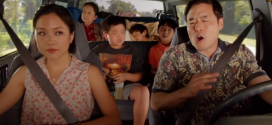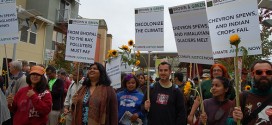20% of Montgomery County AAPIs Live in Poverty
By Michelle Phipps-Evan

Siu Cheung has vivid recollections of what it means to be poor in the District of Columbia. Now 42-years-old, the Chinese immigrant was the youngest of five children. Her family came to the D.C. metro area when she was six years old.
“I grew up in the ‘hood,” said Cheung who lived on Benning Road and East Capitol Street in Southeast’s Ward 7, not far from a District landmark, the Shrimp Boat Seafood restaurant. Her family shared a two-bedroom apartment, and she shared a walk-in closet as a bedroom with her sister.

“We knew we were poor,” said Cheung who went to school in the District and Prince George’s County, Md. “We didn’t know people who were rich. My clothes were always second hand, and the first time I went to a movie, I was 16 or 17 years old.” The family did not take vacations, and no one was there to help with homework after school because everyone worked.
Cheung represented a group of Asian Americans classified as living in poverty, a group seemingly invisible to the larger American society, which views Asians as prosperous, educated, and industrious.
But poverty among Asians is more common than people realize, reaching about 12 percent of the approximately 17.3 million residents of Asian descent, according to the U.S. Census Bureau. In 2011, the census Bureau says the AAPI community made up 5.6 percent of the population (including those classifying themselves as Asian and one or more races.) The Bureau breaks down the overall poverty rate for all Asians at about 12 percent, and 8.7 percent for AAPI families. This number increases to 20 percent for female-headed households and decreases to 6.7 percent when it’s a couple.
The Asian poverty rate is higher than the national average in Montgomery County, Maryland, with an estimated twenty percent of Asians living below the poverty line. In 2010, the federal poverty threshold was set at $23,314 for a family of four. Overall, the percentage of Americans living below the poverty line in 2011 was 15.9 percent, a higher than normal figure resulting from the weak economy.
“We have to confront the stereotype that there are no low-income Asians,” said Surjeet Ahluwalia, executive director of the Asian American Empowerment and Development for Youth and Families (AALEAD), a District-based community organization providing enrichment programs to low-income Asian youth. “Of course, many Asians are successful but the common response from people is, ‘Are there low income Asians?”
Lack of information and the stereotype about the successful Asian American combine to affect Asians doubly. Many Asians are not aware of the work of organizations such as AALEAD or programs administered by the District of Columbia, Maryland and Virginia governments. And often Asian Americans are not targeted for assistance.
The result is that many families like Cheung’s suffer in silence.
Through years of poverty, Cheung said, her family did not apply for or receive any government assistance such as the Supplemental Nutrition Assistance Program (food stamps) or Medicaid, which would have made their existence a bit easier. Life was tough. When Cheung’s family migrated here from Fujian, China in the 1970s, her neighborhood was largely African-American, she said, with no diversity. Residents were not used to seeing a poor Asian family, she says, recalling getting into “four or five fights to protect myself.” Things did get better for the family over the years, however. They adapted to their new life and community, and the family’s fortunes improved as they developed several restaurant businesses.

Poverty rates for specific Asian ethnicities spike higher than the overall population. For Cambodians, for example, the rate is 20.6 percent for all people; Hmong, 28.1 percent; Laotian, 15.9 percent and the rate for Vietnamese is 15 percent. Among Native Hawaiian and other Pacific Islanders, the poverty rate is 17 percent. In contrast, on the lower end are the Koreans at 14.9 percent, the Chinese at 13.5 percent, and the Japanese at 8.4 percent.
There are several reasons for the ethnic disparities, according to the Southeast Asia Resource Action Center (SEARAC) in Northwest DC, a national organization that advances the interests of Cambodian, Laotian, and Vietnamese Americans by “empowering communities through advocacy.”
“One reason is the relatively recent migration history of these groups,” said Pang Houa M. Toy, SEARAC deputy director. “Compared with, for example, some Japanese or Chinese Americans who immigrated to the United States three, four or even five generations ago, Southeast Asian Americans arrived in the U.S. relatively recently, in the 1970s and ‘80s.”
She said the majority of Southeast Asian Americans sought refuge in the United States as a result of the Vietnam War, to escape the Communist takeover of Laos, and to escape the Khmer Rouge regime in Cambodia.
These circumstances led to another reason why Southeast Asian American groups have yet to catch up, she said, because “they came to this country as refugees with almost nothing besides what they could carry as they fled those countries.” Additionally, those fleeing harrowing conditions often suffer from Post Traumatic Stress Disorder from, for example, living in fear or witnessing war-time atrocities. And that makes it even more difficult for them to adjust to living in a new country.
Diane Vy Nguyen-Vu, the Asian and Middle Eastern Community Liaison in Montgomery County’s Office of Community Partnerships, agrees that the needs of the Southeast Asian community are different, and that’s why many struggle.
“Cambodians have been here a certain time so their English may not be as good as others, so language is an issue,” said Nguyen-Vu, who served as the liaison for the past year. “And since they are coming from war-torn countries, many of them have governments they don’t trust.”
Therefore, it takes time to help these communities get over their distrust with a “lot of relationship building and outreach,” said Nguyen-Vu. She creates partnerships with churches, community groups, nonprofits and other government agencies in Maryland’s Montgomery County, which has an Asian population of 14.4 percent out of a total of almost 990,000 residents. Nguyen-Vu said before joining the government agency, she worked with organizations that worked across the entire region, including Virginia, which has some of the largest pockets of Asian Americans.
She said she has seen Asian Americans from Montgomery County head to Northern Virginia, mainly because of the “large boom of Asian Americans there.” According to the Census, Fairfax County and Arlington County have the highest concentration of Asians. Asians constitute the second largest ethnic group in Fairfax County at 18 percent of the 1.1 million people there. In Arlington, it’s 9.7 percent of more than 200,000 people. In the District of Columbia, the number of Asians is small at 3.7 percent.
So why is an Asian American more likely to be poor in Montgomery County? “Let’s face it,” Nguyen-Vu says, “Montgomery County is one of the most expensive areas in the nation.”
Many of Montgomery County’s Asian parents struggle with access to services, including health care. Those who escaped war-torn countries struggle with English. Seniors who have earned Social Security benefits may live only Social Security Income of $600 a month. Nguyen-Vu notes that home foreclosures have “skyrocketed” for a significant number of people. “It’s something we have never seen before,” she added.
For many of these families, the support of extended families can be very significant, said SEARAC’s Pang Houa M. Toy.
“In the Hmong culture, for example, individuals may rely on their extended family to help fund life events such as weddings and funerals,” said Toy, speaking from her own experience as a Hmong American. “Some families will even pool money that individuals can borrow when they need to make a large purchase or to start a business, buy a house, or even pay for their children’s college tuition.”
Asian seniors are a special case, according to the ASEC, which says about 13.5 percent of those above 65 years old live in poverty.
“For many Southeast Asian American elders, it is next to impossible to learn English, which one must demonstrate in order to become a United States citizen,” Toy said. “The lack of citizenship leads to its own set of hardships such as the threat of deportation, not being able to access Supplemental Security Income benefits, and of course, disenfranchisement.”
Although the numbers are high, the overall numbers of Asians living in poverty still remains lower than the overall U.S. population. The 15.9 percent overall poverty rate in 2011 was the fourth consecutive increase in the rate, although the rate of increase has slowed. Nguyen-Vu theorizes that because there is more poverty overall, it is understandable that Asian-American poverty is also rising.
This is why organizations such as the Chinatown Service Center in the District’s Chinatown neighborhood see as many as 300 cases monthly. Although it is not a direct service-provider, many Asians visit the center, which is affiliated with the Chinese Community Church.
“We get a lot of people coming in here for help,” said coordinator Lisa Ma, who added that most of the church members live in Maryland and Virginia. Much of its work involves helping people fill out English language forms for federal or state aid such as food stamps and citizenship workshops. Although it’s not a food provider, the organization offered a full Thanksgiving meal for free on Nov. 22.
Cheung, like many other Chinese immigrants, was able to succeed after years of struggle. Lily Qi, a Chinese immigrant in the U.S. for 24 years, has a theory on that.
“Immigrant poor is not perpetual poverty,” said Qi, special projects manager in Maryland’s Office of the County Executive and a columnist for Asian Fortune. “We were poor and you had moments of despair when you ask yourself, ‘why did I come here?’” But she said she came for opportunities, not just for food, so her focus was a little different.
“Financially, it gets better when you get a job,” said Qi who now lives in Rockville, Md. “There’s a light at the end of the tunnel.”
Groups such as AALEAD, SEARAC, the Chinese Service Center, the Maryland Vietnamese Mutual Association and other government agencies want to make getting to the end of that tunnel a little quicker, a little easier community members in need, nearly two-thirds of whom are foreign born.
An encouraging sign regarding the economic health of the Asian American community is that 49 percent of us hold a Bachelor’s degrees or higher. In comparison, only 28.2 percent of the general population can say the same. Almost 86 percent of people in both the Asian and the general population have high school degrees.
Today, Cheung who is married with three adult children owns her own business, Siu’s Asian Bistro, a restaurant, in Silver Spring, Md. She has a real estate company and is involved with other businesses as well.

“One of the things for me, growing up poor, was that I always wanted to work harder, so I can give to my kids more than I had,” said Cheung. She also gives to the community, serving on the board of AALEAD and working on fundraising efforts to assist more than 300 low-income youth annually. These students represent more than 14 different Asian ethnicities.
“That’s one of the reasons why I work with AALEAD, which provides a safe place for the kids to talk to, and to bridge that cultural gap,” said Cheung, adding that she would have benefited from such an organization if it were around when she was a teenager.
 Asian Fortune Your source for all things Asian American
Asian Fortune Your source for all things Asian American



